

I have recently learned that the solution I describe was popularized by Minh Thai, the National Champion cube solver whose record Time in late 1981 was 26.04 seconds (he was on the TV show "That's Incredible"). He went on to publish a booklet entitled "The Winning Solution" (1982), talking about his method for solving the cube, a "corners first" approach, based on the solution presented by Ideal Toy Company (The Ideal Solution, 1980), the book which I believe I learned this solution from. (Information from the Rubik's FAQ and from Philip R. Marshall's comparison page, comparing various solutions.)
Note: I also have instructions for how to solve a cube when it has pictures on each face. By putting a picture on each face, or even a small logo on the middle-center piece of each face, the orientation of the middle-center pieces becomes significant in order to show the picture correctly. Various moves are described to correct for this problem.
Purchasing Puzzles: If you are having troubles finding stores that sell cubes and similar puzzles, I have a list of on-line sites that may have what you're looking for.
My other cube pages
|
|
See Denny's solution for solving the 3x3x3 cube. This is a more detailed solution for the 3x3 than the one I provide (mirrored from the now missing http://www.calormen.com/vpm/puzzlesolutions/rubikscube/) |

|
See Denny's solution for solving the 4x4x4 cube (mirrored from the now missing http://www.calormen.com/vpm/puzzlesolutions/revenge/) |

|
My directions for Solving the Professor Cube (5x5x5) |
|
|
My directions for Solving the Square 1 |
|
|
My directions for Solving the Pyramix (Pyramid) |
As a preview, the steps are:
NOTE: Only steps 1 through 3 are required for solving a 2x2x2 cube. Furthermore, you only need to match up the corners of the 2x2x2 cube with the corners of the 3x3x3 cube in the diagrams, and the directions will apply perfectly.
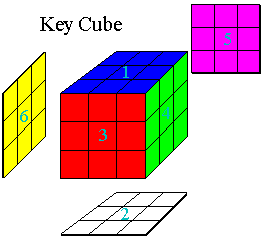
The figures in this document represent a sample cube. Although the colors on your personal Rubik's cube may be different than the figures, I feel that the colored figures will still be helpful in solving the cube. I would suggest matching as many colors on your cube as possible to the figures, then making mental notes about which colors correspond between your cube and the figures. For example, perhaps you can match the red, green, and blue sides exactly, but the yellow in the figures corresponds to pink on your cube. Just keep this equivalency in mind when looking at the figures. In addition, I have numbered the middle-center pieces for reference such that 1 and 2 are opposite each other and 3, 4, 5, and 6 go around the cube in a circle. Finally, the diagrams show all six sides of the cube by pretending that mirrors are being held up so that you may see the "hidden" sides. If you have trouble discerning the difference between green and yellow, try this alternative page.
The directions for what parts of the cube to turn and when are given in a code that is relative to the current positioning of the cube. Each side or slice descriptor refers to a side with respect to the figure the move is referenced to. This means that the front side can be a different color, depending on the diagram being used. The code is easy to follow and instructive diagrams are included for each of the moves.
In the figures, any gray pieces represent pieces that don't matter and can be any color. To increase clarity, I have shown a lot of colored pieces. In most cases, the figures represent an example of the situation being described, while the colors don't have to match perfectly, particularly when I describe correctly positioned yet incorrectly rotated pieces. Wherever I have placed numbers on the pieces in the figures, though, they should match up perfectly.
Hopefully you can accomplish Step 1 without any help from me. It's just a matter of moving pieces out of the way to insert desired pieces in the correct locations. Still, if you would like further help on this, follow me to the Step 1 page.
2a. If the two corners in the correct position are parallel (in line on the same edge):
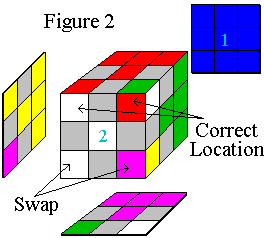
|
Orient the cube as shown in Figure 2 where the two corner pieces in the correct position are at the front-top corners of the cube and the two corner pieces in the incorrect position are at the front-bottom corners of the cube. Perform Move 1, then proceed to step 3. |
Move 1: U-1 F U L-1 U L U-1 F2
|
|
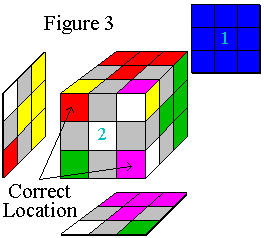
|
Orient the cube as shown in Figure 3, with side 1 in the back and either of the correctly positioned corners in the top-left-front and bottom-right-front positions. Perform Move 1, then go back to step 2, progressing to step 2a after correctly rotating Side 2 as instructed. |
Examine side 2 of the cube. Zero, one, two, three, or even four of the corner pieces will be oriented correctly such that they perfectly line up with their adjacent middle-center pieces. If all four are correct, the cube should look as shown in Figure 8 (below). If not:
3a. For zero correctly oriented pieces:
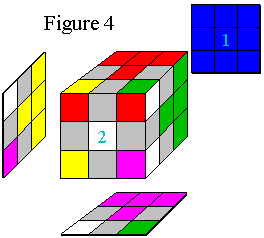
|
Position the cube as shown in Figure 4 such that Side 2 is facing you. Perform Move 2, then return to the start of step 3. |
|
Move 2: U-1 F2 U F U-1 F U F2 In words, rotate the upper side (red here) one quarter turn counter-clockwise, then the front side (white here) two quarter turns (half-way around), then the upper side 1/4 turn clockwise, etc. |
|
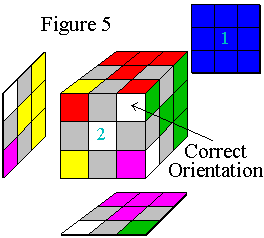
|
Position the cube as shown in Figure 5. Perform Move 2, then return to the start of step 3 only if the four corner pieces of side 2 are not oriented correctly. If they are correct, as shown in Figure 8, go to step 4. |
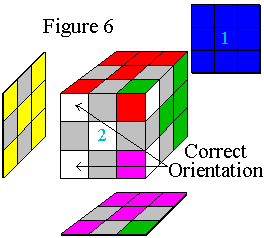
|
Position the cube as shown in Figure 6. Perform Move 2, then return to the start of step 3. |
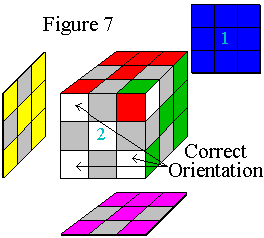
|
It is not possible to have 7 corners oriented correctly while just one is incorrect. If your cube is in fact like this then it has been disassembled in the past and incorrectly reassembled. You will have to disassemble it again and reassemble correctly. |
NOTE: Step 3 may need to be repeated numerous times. Also, the move directly before all four corner pieces are oriented correctly will have just one piece oriented correctly, as shown in Figure 5 (step 3b).
|
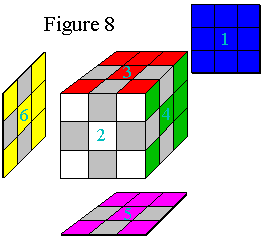
|
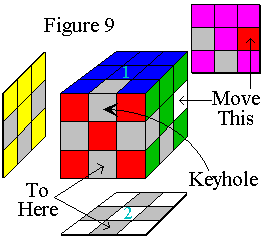
|
If the cube looks like Figure 9, then Move 3 will put the piece into place. |
|
Move 3: F H2 F-1 In words, rotate the front side (red here) one quarter turn clockwise, then the middle horizontal slice (containing the red, green, pink, and yellow middle-center pieces) two quarter turns (half-way around), then the front side one quarter turn counter clockwise. |
|
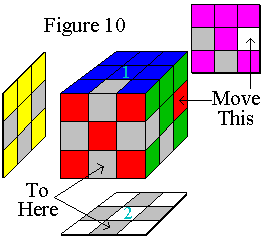
|
If the cube looks like Figure 10, then Move 4 will put the piece into place. |
|
Move 4: F-1 H F In words, rotate the front side (red here) one quarter turn counter clockwise, then the middle horizontal slice (containing the red, green, pink, and yellow middle-center pieces) one quarter turn clockwise (so that the red/white corner piece moves toward the front), then the front side one quarter turn clockwise. |
|
Orient the cube as shown in Figure 11 or Figure 12, depending on how the keyhole piece is oriented in the middle horizontal slice. If the keyhole piece is already in the keyhole but oriented incorrectly, simply move it out by using Move 3 or 4 (it doesn't matter which) and go back to step 4.
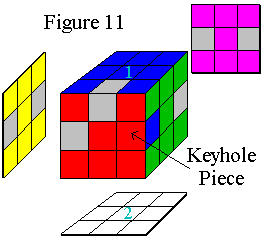
|
If the cube looks like Figure 11, then Move 5 will put the piece into place. |
|
Move 5: F H-1 F-1 H-1 F H F-1 In words, rotate the front side (red here) one quarter turn clockwise, the middle horizontal slice (between the blue and white sides) one quarter turn counter clockwise (so that the red/blue corner piece moves toward the back), the front 1/4 turn counter clockwise, etc. |
|
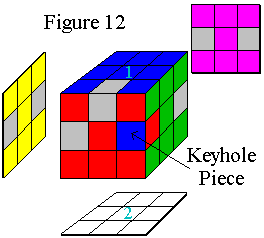
|
If the cube looks like Figure 12, then Move 6 will put the piece into place. |
|
Move 6: F H-1 F-1 H2 F-1 H-1 F In words, rotate the front side (red here) one quarter turn clockwise, the middle horizontal slice (between the blue and white sides) one quarter turn counter clockwise (so that the red/blue corner piece moves toward the back), the front 1/4 turn counter clockwise, etc. |
|
Position the cube as shown in Figure 13, with side 1 on the right. Now the slice we have been calling the middle horizontal slice has become the middle vertical slice, V. Rotate the middle vertical slice and side 2 until each middle-center piece matches up with its corresponding side 1 and side 2 edge and corner pieces. Examine the four remaining center-edge pieces.
6a. If none of the four center-edge pieces is in the correct position:
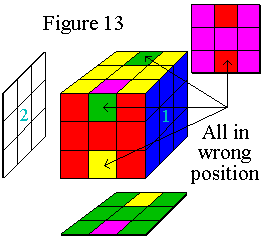
|
Position the cube as shown in Figure 13, placing side 1 on the right and side 2 on the left (the rest don't matter here). Perform Move 7, then proceed to step 6b. |
|
Move 7: V U2 V-1 U2 In words, rotate the middle vertical slice (between the blue and white sides) one quarter turn clockwise (away from you), the top side (yellow here) two quarter turns (half-way around), the vertical slice 1/4 turn counter-clockwise (back toward you), and the top half-way around again. |
|
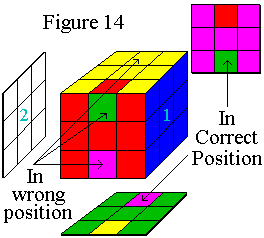
|
Position the cube as shown in Figure 14, placing the correctly positioned (not necessarily oriented) center-edge piece to the back of the cube so that it cannot be seen. Perform Move 7, one, two, or three times until each center-edge piece is in the correct position. Proceed to step 6d. |
6d. When all four center-edge pieces are correctly positioned, proceed to step 7.
The following "Rube Move", named after Mr. Rubik himself (since he formulated it), will flip the two center-edge pieces on the top side of the cube shown in Figure 15.
If two center-edge pieces are correct and the two that are wrong are diagonal to each other then perform step 7b and proceed to step 7a.
7a. For parallel misoriented pieces:
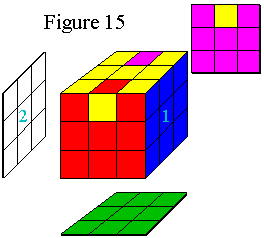
|
First orient the cube so that the two misoriented center-edge pieces are on the top side of the cube as shown in Figure 15 and perform Move 8. Next, place the remaining two center-edge pieces in the top positions and, if misoriented, perform Move 8. |
|
Move 8: V U V U V U2 V-1 U V-1 U V-1 U2 In words, rotate the middle vertical slice (between the blue and white sides) one quarter turn clockwise (away from you), the top side 1/4 turn clockwise, the vertical slice 1/4 turn up, the top 1/4 turn clockwise, the vertical slice 1/4 turn up, the top two quarter turns (half-way around), the vertical slice 1/4 turn counter-clockwise (back toward you), the top 1/4 turn clockwise, etc. |
|
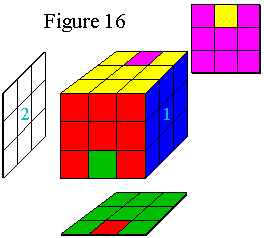
|
Position the cube as shown in Figure 16. Rotate the front (red side) two turns (F2), perform Move 8, then rotate the front two more turns (F2). You are essentially making the cube look like Figure 15, then using Move 8, then re-orienting the front pieces. |
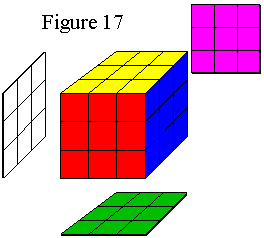
|
Congratulations, you've solved the cube. |
If you have pictures on the faces of your cube, or a logo on the middle-center piece of each side, see these instructions for extra help.
I hope you have found these directions to be clear and complete, yet concise. If these directions help you to solve the cube, I would enjoy hearing from you.
Contact info: I appreciate receiving e-mails describing your success with these directions, but I cannot provide any additional help in solving the Rubik's cube beyond the instructions and steps shown here. Please also e-mail if you have problems accessing a page or seeing a graphic.

Last Modified May 9, 2009